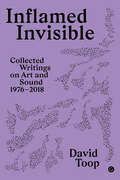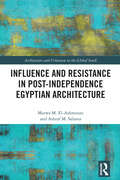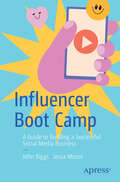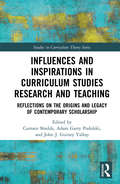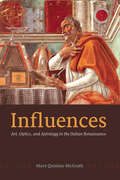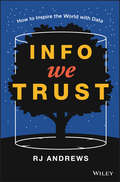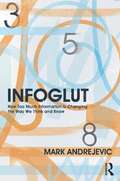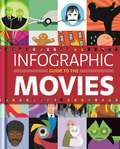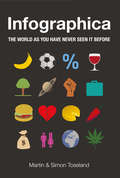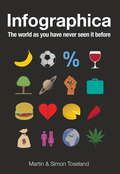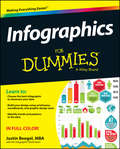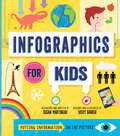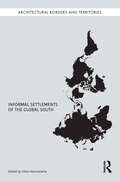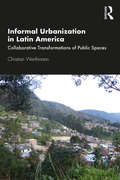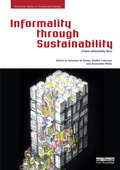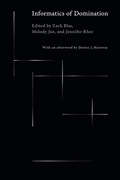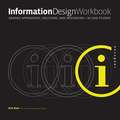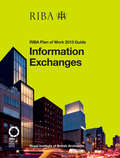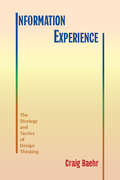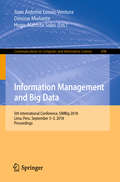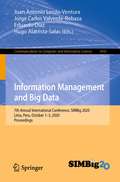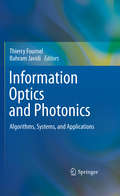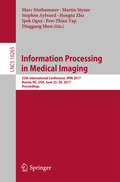- Table View
- List View
Inflamed Invisible: Collected Writings on Art and Sound, 1976-2018 (Goldsmiths Press / Sonics Series #2)
by David ToopA rich collection of essays tracing the relationship between art and sound. In the 1970s David Toop became preoccupied with the possibility that music was no longer bounded by formalities of audience: the clapping, the booing, the short attention span, the demand for instant gratification. Considering sound and listening as foundational practices in themselves leads music into a thrilling new territory: stretched time, wilderness, video monitors, singing sculptures, weather, meditations, vibration and the interior resonance of objects, interspecies communications, instructional texts, silent actions, and performance art. Toop sought to document the originality and unfamiliarity of this work from his perspective as a practitioner and writer. The challenge was to do so without being drawn back into the domain of music while still acknowledging the vitality and hybridity of twentieth-century musics as they moved toward art galleries, museums, and site-specificity. Toop focused on practitioners, whose stories are as compelling as the theoretical and abstract implications of their works.Inflamed Invisible collects more than four decades of David Toop's essays, reviews, interviews, and experimental texts, drawing us into the company of artists and their concerns, not forgetting the quieter, unsung voices. The volume is an offering, an exploration of strata of sound that are the crossing points of sensory, intellectual, and philosophical preoccupations, layers through which objects, thoughts and air itself come alive as the inflamed invisible.
Influence and Resistance in Post-Independence Egyptian Architecture (Architecture and Urbanism in the Global South)
by Ashraf M. Salama Marwa M. El-AshmouniThis book is an effort towards an in-depth understanding of the architectural discourse in Egypt developed over more than eight decades. It offers a distinctive theoretical interpretation of the forces shaping the kaleidoscopic shifts in Egyptian architecture through the analysis of the micro space of architectural representation of twentieth century Egyptian architecture. Predicated on historical contextualization, theoretical integration, and global conceptualization, Edward Said’s analytical method of contrapuntal reading and the spatial discourse analysis posited by C. Greig Crysler are lucidly assimilated to generate insights into various voices within the architectural discourse in Egypt. The analysis and critique of two important professional magazines, al-‘Imarah (1939–1959) and ‘Alam al-Bena’a (1980–2000), which shaped the collective psyche of both the academic and professional communities in Egypt and the wider region, coupled with the exploration of two other short-lived magazines, M‘imaryah (1982–1989) Medina (1998–2002), and other less-influential professional magazines, discloses the structure of attitude and reference or the exclusions and inclusions that defined the boundaries of the space of the discourse. Influence and Resistance in Post-Independence Egyptian Architecture paves the way to genuinely debate a yet to mature twenty-first century’s architectural discourse in Egypt. This book is a key resource for architects, architectural historians, and critical theorists and will appeal to academics and to both graduate and advanced undergraduate students in architectural history and theory and Middle East and Global South studies.
Influencer Boot Camp: A Guide to Building a Successful Social Media Business
by John Biggs Jessa MooreLearn how to leverage your own social media through techniques used by influencer agencies and successful digital marketers. Influencer marketing can amplify word of mouth and reputation to energize your own community. This book traces the history of influencer marketing, highlighting key milestones and shifts in consumer preferences. It guides readers on discovering their unique niche within the influencer space, emphasizing the importance of authenticity and passion. It shows you strategies for developing a strong personal brand that resonates with your target audience and sets you apart from competitors. It shares practical tips and techniques for creating compelling content across various platforms, including visual storytelling, copywriting, and video production. Through this book, you will learn techniques to communicate your story, manage your reputation, and grow your own influence.
Influences and Inspirations in Curriculum Studies Research and Teaching: Reflections on the Origins and Legacy of Contemporary Scholarship (Studies in Curriculum Theory Series)
by Carmen Shields Adam Garry Podolski John J. Guiney YallopThis volume highlights lived experiences, personal inspirations and motivations, which have generated scholarship, and influenced the research and teaching of scholars in the field of curriculum studies. Offering contributions from new, established and experienced scholars, chapters foreground the ways in which the authors have been influenced by the mentorship and work of others, by personal challenges, and by the contexts in which they live and work. Chapters also illustrate how scholars have engaged in variety of methodological and autobiographical processes including narrative and poetic inquiry, autoethnography and visual arts research. Through a range of contributions, the book clarifies the origins and legacy of contemporary curriculum studies and in doing so, provides inspiration for beginning scholars and academics as they continue to find their voices in academic communities. Offering rich insight into the experiences and scholarship of a wide range of scholars, this volume will be of interest to students, scholars and researchers with an interest in curriculum studies, as well as educational research and methodologies more broadly.
Influences: Art, Optics, and Astrology in the Italian Renaissance
by Mary Quinlan-McGrathToday few would think of astronomy and astrology as fields related to theology. Fewer still would know that physically absorbing planetary rays was once considered to have medical and psychological effects. But this was the understanding of light radiation held by certain natural philosophers of early modern Europe, and that, argues Mary Quinlan-McGrath, was why educated people of the Renaissance commissioned artworks centered on astrological themes and practices. Influences is the first book to reveal how important Renaissance artworks were designed to be not only beautiful but also—perhaps even primarily—functional. From the fresco cycles at Caprarola, to the Vatican’s Sala dei Pontefici, to the Villa Farnesina, these great works were commissioned to selectively capture and then transmit celestial radiation, influencing the bodies and minds of their audiences. Quinlan-McGrath examines the sophisticated logic behind these theories and practices and, along the way, sheds light on early creation theory; the relationship between astrology and natural theology; and the protochemistry, physics, and mathematics of rays. An original and intellectually stimulating study, Influences adds a new dimension to the understanding of aesthetics among Renaissance patrons and a new meaning to the seductive powers of art.
Info We Trust: How to Inspire the World with Data
by Rj AndrewsHow do we create new ways of looking at the world? Join award-winning data storyteller RJ Andrews as he pushes beyond the usual how-to, and takes you on an adventure into the rich art of informing. Creating Info We Trust is a craft that puts the world into forms that are strong and true. It begins with maps, diagrams, and charts — but must push further than dry defaults to be truly effective. How do we attract attention? How can we offer audiences valuable experiences worth their time? How can we help people access complexity? Dark and mysterious, but full of potential, data is the raw material from which new understanding can emerge. Become a hero of the information age as you learn how to dip into the chaos of data and emerge with new understanding that can entertain, improve, and inspire. Whether you call the craft data storytelling, data visualization, data journalism, dashboard design, or infographic creation — what matters is that you are courageously confronting the chaos of it all in order to improve how people see the world. Info We Trust is written for everyone who straddles the domains of data and people: data visualization professionals, analysts, and all who are enthusiastic for seeing the world in new ways. This book draws from the entirety of human experience, quantitative and poetic. It teaches advanced techniques, such as visual metaphor and data transformations, in order to create more human presentations of data. It also shows how we can learn from print advertising, engineering, museum curation, and mythology archetypes. This human-centered approach works with machines to design information for people. Advance your understanding beyond by learning from a broad tradition of putting things “in formation” to create new and wonderful ways of opening our eyes to the world. Info We Trust takes a thoroughly original point of attack on the art of informing. It builds on decades of best practices and adds the creative enthusiasm of a world-class data storyteller. Info We Trust is lavishly illustrated with hundreds of original compositions designed to illuminate the craft, delight the reader, and inspire a generation of data storytellers.
Infoglut: How Too Much Information Is Changing the Way We Think and Know
by Mark AndrejevicToday, more mediated information is available to more people than at any other time in human history. New and revitalized sense-making strategies multiply in response to the challenges of "cutting through the clutter" of competing narratives and taming the avalanche of information. Data miners, "sentiment analysts," and decision markets offer to help bodies of data "speak for themselves"—making sense of their own patterns so we don’t have to. Neuromarketers and body language experts promise to peer behind people’s words to see what their brains are really thinking and feeling. New forms of information processing promise to displace the need for expertise and even comprehension—at least for those with access to the data. Infoglut explores the connections between these wide-ranging sense-making strategies for an era of information overload and "big data," and the new forms of control they enable. Andrejevic critiques the popular embrace of deconstructive debunkery, calling into question the post-truth, post-narrative, and post-comprehension politics it underwrites, and tracing a way beyond them.
Infographic Guide To The Movies (Infographic Guides)
by Karen Krizanovich"Naturally, there are all the types of information you'd expect to find in a book like this... but there's a whole lot more than that on offer here." - Starburst Magazine100 stunning, ingenious and absorbing movie infographics!Infographic Guide to Movies presents unique, witty and surprising facts about every film genre, from blockbuster, rom-com, horror, crime, sci-fi and action, to noir, zombie, nouvelle vague, slasher, erotica, world cinema and much, much more. Mixing cinematic fact with legend, it features infamous and often ludicrous tales of Hollywood, Bollywood, European cinema, underground and indie filmmaking.More than just a book of words, with graphs, Venn diagrams and charts, this book provides a unique overview of the movie world, boasting over 100 original artworks and illustrations and at-a-glance facts to amaze and astound readers-such as whether movies with a naked Helen Mirren or a naked Zach Galifiankis are likely to be more successful in Albania. There are graphics on every major movie genre and market in the world.Discover...Where in the world you're most likely to come across zombies.What the ultimate leading man would look like.Which actor was the best Bond.Who would win a fight between Rocky and Rambo.Judd Apatow's secret formula. How to kill Bruce Willis.How to get from Thomas Hardy to Tom Hardy.How much rom in a com makes the perfect rom-com. And so much more!
Infographica
by Simon Toseland Martin ToselandInfographica collects intriguing data from across the planet--for instance, the average lifespan of people living on each continent, the relative durations of the world's unmanned space probes, or the bite strength of the world's most dangerous predators--and presents it in stylish, inventive, and original infographics. Quirky, irreverent, and visually appealing, this book is a must-have reference for anyone wishing to keep informed, as well as a primer on information design from the writing and design team of Martin and Simon Toseland.From the Trade Paperback edition.
Infographica: The World as You Have Never Seen it Before
by Simon Toseland Martin ToselandEver wanted to see the world in a new way? Infographica collects intriguing data from across our planet - including facial hair styles of famous dictators, the countries with the most McDonald's restaurants and the world's most expensive divorces - and presents it in stylish, memorable and original infographics. Quirky, irreverent and visually appealing, this book is a must for everyone wishing to keep informed, and be inspired, by innovative graphic design.
Infographics For Dummies
by The Infographic World Team Justin BeegelCreate stunning infographics with this hands-on guideInfographics For Dummies is a comprehensive guide to creating data visualization with viral appeal. Written by the founder of Infographic World, a New York City based infographic agency, and his top designers, the book focuses on the how-to of data, design, and distribution to create stunning, shareable infographics. Step-by-step instruction allows you to handle data like a pro, while creating eye-catching graphics with programs like Adobe Illustrator and Photoshop. The book walks you through the different types of infographics, explaining why they're so effective, and when they're appropriate.Ninety percent of the information transmitted to your brain is visual, so it's important to tickle the optic nerves to get people excited about your data. Infographics do just that. Much more exciting than a spreadsheet, infographics can add humor, interest, and flash while imparting real information. Putting your data in graphic form makes it more likely to be shared via Twitter, Facebook, Pinterest, and other social media sites, and the visual interest makes it less likely to be ignored. Infographics For Dummies provides a tried-and-true method for creating infographics that tell a story and get people excited. Topics include:Talking to clients about the dataDiscovering trends, outliers, and patternsDesigning with mood boards and wireframesLaunching and promoting your infographicThe book, written by Justin Beegel, MBA, founder of Infographic World, Inc., describes the elements of a successful infographic, and stresses the must-have ingredients that get your data noticed. Humans are visual creatures, telling stories in a visual way. In today's world filled with data and messaging, an infographic is one of the best ways to get your point across.
Infographics for Kids
by Susan MartineauVisual fluency for the digital native In a world of fast-moving news, unwavering digital exposure, and informational memes, kids (and adults) are bombarded with infographics. Presenting information in the form of images accompanied by minimal text, infographics convey an easily understood overview of a complex subject visually. Infographics for Kids playfully instructs readers on how information can be arranged and presented in graphic format, inviting kids to add their own personal touches with fun consumable activity pages that introduce key communications skills for digital natives.
Informal Settlements of the Global South (Architectural Borders and Territories)
by Gihan KarunaratneBringing together case studies ranging across the globe, including theUS-Mexico borderlands, the Calais encampment in France, refugee camps in Kenya, Uganda and Bangladesh and contested ‘informal’ enclaves and communities in the cities of India, China, Brazil, Nigeria and South Africa, this book challenges current ways of thinking about the governance of human settling, mobility and placemaking. Together, the 15 essays question the validity of the conventional hegemonic divisions of Global North vs. Global South and ‘formal’ vs. ‘informal’, in terms of geographic presence, transborder performances and the ideological inter-dependence of Northern and Southern spaces, spatial practices and the uniformity of authoritative enforcements. The book, whose authors themselves come from all over the world, uses ‘Global South’ as a methodological apparatus to ask the ‘Southern’ question of settling and unsettling across the globe. Crucially, the studies reveal the sentiments, resourcefulness and the agency of those positioned by the powerful within the dichotomies of formal/informal, legitimate/ illegal, privileged/marginalized, etc., who are traditionally identified within the dominant development discourse as mere numbers or designated by intervening institutions as helpless recipients. By focussing on hitherto invisible events and untold stories of adaptation, negotiation and contestation by people and their communities, this volume of essays takes the ongoing North-South debate in new directions and opens up to the reader’s fresh areas of enquiry. It will be of interest to researchers and students of architecture, planning, politics and sociology, as well as built environment professionals.
Informal Urbanization in Latin America: Collaborative Transformations of Public Spaces
by Christian WerthmannVarious kinds of informal and extra-legal settlements—commonly called shantytowns, favelas, or barrios—are the prevailing type of urban land use in much of the developing world. United Nations estimates suggest that there are close to 900 million people living in squatter communities worldwide, with the number expected to increase in the coming decades. Informal Urbanization in Latin America investigates prevailing strategies for addressing informal settlements, which started to shift away from large-scale slum clearance to on-site upgrading in Latin America over the last 40 years, by improving public spaces, infrastructure and facilities. The cases in this book range from one micro intervention (the Villa Tranquila Project in Buenos Aires) to three large-scale government-run projects: the celebrated Favela Bairro Program in Rio de Janeiro, the social housing program in São Paulo and the famous Proyectos Urbanos Integrales Approach in Medellín. The cases show a collaborative and sensitive transformation of landscape and public space, and provide designers and planners with the tools to develop better strategies that can mitigate the volatility that the residents of non-formal neighborhoods are exposed to. The book is a must-read for all who are interested or working in the global urbanization as well as social equity.
Informality through Sustainability: Urban Informality Now (Earthscan Series On Sustainable Design Ser.)
by Steffen Lehmann Alessandro Melis Antonino Di RaimoInformality through Sustainability explores the phenomenon of informality within urban settlements and aims to unravel the subtle links between informal settlements and sustainability. Penetrating its global profile and considering urban informality through an understanding of local implications, the authors collectively reveal specific correlations between sites and their local inhabitants. The book opposes simplistic calls to legalise informal settlements or to view them as ‘problems’ to be solved. It comes at a time when common notions of ‘informality’ are being increasingly challenged. In 25 chapters, the book presents contributions from well-known scholars and practitioners whose theoretical or practical work addresses informality and sustainability at various levels, from city planning and urban design to public space and architectural education. Whilst previous studies on informal settlements have mainly focused on cases in developing countries, approaching the topic through social, cultural and material dimensions, the book explores the concept across a range of contexts, including former Communist countries and those in the so-called Global North. Contributions also explore understandings of informality at various scalar levels – region, precinct, neighbourhood and individual building. Thus, this work helps reposition informality as a relational concept at various scales of urbanisation. This book will be of great benefit to planners, architects, researchers and policymakers interested in the interplay between informality and sustainability.
Informatics of Domination
by Donna J. HarawayInformatics of Domination is an experimental collection addressing formations of power that manifest through technical systems and white capitalist patriarchy in the twenty-first century. The volume takes its name from a chart in Donna J. Haraway’s canonical 1985 essay “A Manifesto for Cyborgs.” Haraway theorizes the informatics of domination as a feminist, diagrammatic concept for situating power and a world system from which the figure of the cyborg emerges. Informatics of Domination builds on Haraway’s chart as an open structure for thought, inviting fifty scholars, artists, and creative writers to unfold new perspectives. Their writings take on a variety of forms, such as essays on artificial intelligence, disability and protest, and transpacific imaginaries; conversations with an AI trained on Black oral history; a three-dimensional response to Mexico-US border tensions; hand-drawn images on queer autotheory; ecological fictions about gut microbiomes and wet markets; and more. Together, the writings take up the unfinished structure of the chart in order to proliferate critiques of white capitalist patriarchal power with the study of information systems, networks, and computation today. This volume includes an afterword by Haraway.Contributors. Dalida María Benfield, Zach Blas, Ama Josephine Budge Johnstone, micha cárdenas, Amy Sara Carroll, Shu Lea Cheang, Jian Neo Chen, Heather Dewey-Hagborg, Ranjodh Singh Dhaliwal, Stephanie Dinkins, Ricardo Dominguez, Ashley Ferro-Murray, Matthew Fuller, Jacob Gaboury, Jennifer Gabrys, Alexander R. Galloway, Jennifer Mae Hamilton, Donna J. Haraway, Eva Hayward, Stefan Helmreich, Kathy High, Leon J. Hilton, Ho Rui An, Hi'ilei Julia Kawehipuaakahaopulani Hobart, Tung-Hui Hu, Caroline A. Jones, Melody Jue, Homay King, Larissa Lai, Lawrence Lek, Esther Leslie, Alexis Lothian, Isadora Neves Marques, Radha May (Elisa Giardina-Papa, Nupur Mathur, and Bathsheba Okwenje), Shaka McGlotten, Mahan Moalemi, madison moore, Astrida Neimanis, Bahar Noorizadeh, Luciana Parisi, Thao Phan, Ana Teixeira Pinto, Luiza Prado de O. Martins, Rita Raley, Patricia Reed, Jennifer Rhee, Bassem Saad, Ashkan Sepahvand, Justin Talplacido Shoulder, Lucy Suchman, Ollie Zhang
Information Architecture: For the Web and Beyond
by Peter Morville Louis Rosenfeld Jorge ArangoInformation architecture (IA) is far more challenging—and necessary—than ever. With the glut of information available today, anything your organization wants to share should be easy to find, navigate, and understand. But the experience you provide has to be familiar and coherent across multiple interaction channels, from the Web to smartphones, smartwatches, and beyond.To guide you through this broad ecosystem, this popular guide—now in its fourth edition—provides essential concepts, methods, and techniques for digital design that have withstood the test of time. UX designers, product managers, developers, and anyone involved in digital design will learn how to create semantic structures that will help people engage with your message.This book includes:An overview of IA and the problems it solves for creating effective digital products and servicesA deep dive into IA components, including organization, labeling, navigation, search, and metadataProcesses and methods that take you from research to strategy, design, and IA implementation
Information Design Workbook: Graphic Approaches, Solutions, and Inspiration + 30 Case Studies
by Kim Baer<p>New in paperback, this workbook is a methodical yet comprehensive approach to conveying the fundamentals of avant-garde, innovative, information design by examining history, theory, criticism, technology and media, process, method, and practice. <p>Opening with a very brief history followed by an instructive breakdown of the discipline, readers get an intimate understanding of the complexities of crafting information design to effectively improve communication both functionally and aesthetically. The back half of the book contains a wide range of case studies from design firms around the world so designers can see the techniques previously outlined in the first half of the book. The author also critiques and explains why the design is successful in terms of formal quality (Aesthetics) and function (How does it improve communication?).</p>
Information Exchanges: RIBA Plan of Work 2013 Guide
by Richard FairheadThe RIBA Plan of Work 2013 Guide: Design Management is part of a brand new series providing must-read practical guidance to running efficient and successful projects using the new RIBA Plan of Work 2013. Each guide takes a core project task – in this case managing information exchanges - and explains the essential activities and considerations required at each stage of the new Plan of Work. Easy to use and navigate and in a small and handy format these guides will provide the ultimate quick reference support at your desk or on site. The author provides concise and pragmatic advice rooted in real world experience – a ‘how to’ that will resonate with practitioners. In-text features such as ‘hints and tips’, ‘checklists’, ‘forms and templates’ and ‘signposts’ to trusted resources will provide user-friendly support. Boxed examples will highlight best practice and illuminate common problems and solutions borne of hard won experience.
Information Experience: The Strategy and Tactics of Design Thinking (SUNY series, Studies in Technical Communication)
by Craig BaehrInformation isn't simply read or used, rather it creates a holistic experience for users.Information Experience provides a usable framework for developing information products and design thinking practices for a wide range of projects, including application development, content creation, instructional materials, and user experience design. Whether content is created by human, machine, or artificial intelligence, memorable information experiences begin with the user, encompassing how user research, content development strategies, and design tactics fit together in creating engaging information experiences and products. The book provides an in-depth discussion of the components of information experience, including user perception, cognition, environment design, strategic branding, and tactical design. Collectively, these elements provide a foundation for understanding how information products function on a level beyond utility, as holistic and immersive experiences for users.
Information Inequality
by Herbert SchillerHerbert Schiller, long one of America's leading critics of the communications industry, here offers a salvo in the battle over information. In Information Inequality he explains how privatization and the corporate economy directly affect our most highly prized democratic institutions: schools and libraries, media, and political culture. A master media-watcher, Schiller presents a crisp and far-reaching indictment of the "data deprivation" corporate interests are inflicting on the social fabric.
Information Management and Big Data: 5th International Conference, SIMBig 2018, Lima, Peru, September 3–5, 2018, Proceedings (Communications in Computer and Information Science #898)
by Juan Antonio Lossio-Ventura Hugo Alatrista-Salas Denisse MuñanteThis book constitutes the refereed proceedings of the 5th International Conference on Information Management and Big Data, SIMBig 2018, held in Lima, Peru, in September 2018. The 34 papers presented were carefully reviewed and selected from 101 submissions. The papers address issues such as data mining, artificial intelligence, Natural Language Processing, information retrieval, machine learning, web mining.
Information Management and Big Data: 7th Annual International Conference, SIMBig 2020, Lima, Peru, October 1–3, 2020, Proceedings (Communications in Computer and Information Science #1410)
by Juan Antonio Lossio-Ventura Hugo Alatrista-Salas Jorge Carlos Valverde-Rebaza Eduardo DíazThis book constitutes the refereed proceedings of the 7th International Conference on Information Management and Big Data, SIMBig 2020, held in Lima, Peru, in October 2020.*The 32 revised full papers and 7 revised short papers presented were carefully reviewed and selected from 122 submissions. The papers address topics such as natural language processing and text mining; machine learning; image processing; social networks; data-driven software engineering; graph mining; and Semantic Web, repositories, and visualization. *The conference was held virtually.
Information Optics and Photonics
by Bahram Javidi Thierry FournelThis book will address the advances, applications, research results, and emerging areas of optics, photonics, computational approaches, nano-photonics, bio-photonics, with applications in information systems. The objectives are to bring together novel approaches, analysis, models, and technologies that enhance sensing, measurement, processing, interpretation, and visualization of information. The book will concentrate on new approaches to information systems, including integration of computational algorithms, bio-inspired models, photonics technologies, information security, bio-photonics, and nano-photonics. Applications include bio-photonics, digitally enhanced sensing and imaging systems, multi-dimensional optical imaging and image processing, bio-inspired imaging, 3D visualization, 3D displays, imaging on nano-scale, quantum optics, super resolution imaging, photonics for biological applications, microscopy, information optics, and holographic information systems.
Information Processing in Medical Imaging: 25th International Conference, IPMI 2017, Boone, NC, USA, June 25-30, 2017, Proceedings (Lecture Notes in Computer Science #10265)
by Marc Niethammer, Martin Styner, Stephen Aylward, Hongtu Zhu, Ipek Oguz, Pew-Thian Yap and Dinggang ShenThis book constitutes the proceedings of the 25th International Conference on Information Processing in Medical Imaging, IPMI 2017, held at the Appalachian State University, Boon, NC, USA, in June 2017. The 53 full papers presented in this volume were carefully reviewed and selected from 147 submissions. They were organized in topical sections named: analysis on manifolds; shape analysis; disease diagnosis/progression; brain networks an connectivity; diffusion imaging; quantitative imaging; imaging genomics; image registration; segmentation; general image analysis.
